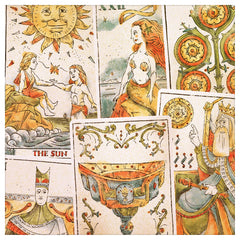The History of Tarot

Card reading (for fun and profit) has a long history, but maybe not as long as you think.
The Pennyland Handbook of Cartomancy that was given to the amusement park employees at the fortune teller tent instructed staff to “Explain that this deck has been passed down from seer to seer since ancient Egypt… and was given to you by an Ancient Swami, Wandering Gypsy or Exalted Mystic from somewhere in the near or far east.” However they also told staff to “be sure to open any new packs behind the tent,” since it was clear their decks didn’t date to Ancient Egypt. The amusement park even sold the cards in their gift shop which doesn’t really follow the ancient tradition of passing them down from seer to seer (although it does follow the ancient tradition of merchandising).
What Pennyland understood very well is that the meaning people give to objects or images is the source of their strength – a dream of chili peppers can be one man’s spicy romance and another man’s eye-watering misery; it’s just the meaning that we apply which makes the difference. So for Pennyland, whether or not you believed that the cards provided access to The Great Beyond didn’t matter so long as you were having a good time. To the Pennyland staff, it was all just a game.
And actually, that’s how it all started.
The first tarot deck appeared in Northern Italy around the 15th century. It was used for popular card games (and gambling) and was one of the first trump-taking games as a precursor to modern games like bridge. In fact, tarot and its variations is still a very popular game in France, Italy and Austria (and if you’ve never played it, I highly recommend you get a deck and give it a try – it’s fast-paced fun). It remained a simple card game for several centuries, and only became widely associated with telling fortunes after cartomancy with normal playing cards became common in France.
Although many people believe that tarot cards are associated with satan worship, the cards actually were created using Christian allegory and symbolism. The Tarot of Marseilles, named for the city in the south of France which was once a center of manufacturing for playing cards, is one of the most common types of decks produced, and influenced the design of most decks to follow. Created in the 17th century, the Tarot of Marseilles used characters and scenes which reflected aspects of the Christian cultural environment players lived in. The images contain political, religious and allegorical figures from Christian teachings, and were so designed to be easily recognizable to the widest audience, most of whom were illiterate.
It was late in the 18th century when followers of the occult saw the symbolic pictures of tarot cards as more than simple trump cards. They used the cards as a divination tool and began to include the cards as a part of occult philosophy. The deck which influenced tarot cards’ place in the occult – and the look and symbolism of most divination decks today – is the Rider-Waite deck, created in 1909 by A. E. White and artist Pamela Colman Smith and published by Rider & Company.
While people generally think of divination in terms of foretelling the future, most practitioners agree that the cards are not really meant to tell your fortune. According to the Hermetic Order of the Golden Dawn which introduced tarot to most followers of the occult through the Rider-Waite deck in the early 1900s, a tarot reading is actually supposed to give you a greater understanding of your own subconscious mind. A tarot reading can be a way for the brain to relax and let patterns form, even without anything spiritual behind the cards themselves. Your interpretation of the cards is a result of the experiences in your life that shape who you are and what you desire. In this way – just like the Rorschach inkblot test – the tarot can be useful in helping to tap into the subconscious mind to find answers that might not occur consciously.
Today, tarot decks created only for divination incorporate the number of the suit card into illustrations, which means that you have to pay a lot closer attention to if you’re using them for game play. However, decks exist that are solely designed for game play, especially in France and Austria, and some like the Musterberg Tarot can be used for both purposes equally well.
Whether you invite some friends over for a hand or two of the card game, or you deal out some spreads to look into The Great Beyond, have fun with it. We’re happy to make the Musterberg Tarot Deck available again and that by doing so can follow in the tradition of the Pennyland Handbook to “give the folks a good time.”